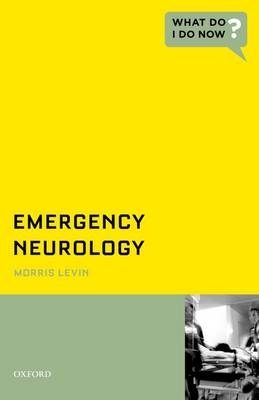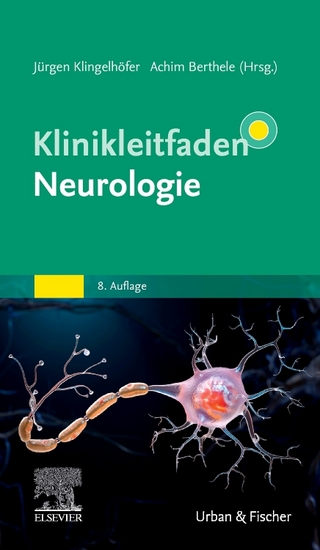
Emergency Neurology
Oxford University Press Inc (Verlag)
978-0-19-986285-6 (ISBN)
- Titel ist leider vergriffen;
keine Neuauflage - Artikel merken
Authored by Morris Levin, along with colleagues from the Dartmouth-Hitchcock Medical Center, this volume presents 32 common urgent/emergent cases divided in to four distinct sections: (1) Diagnostic Questions (ADULT), (2) Treatment Considerations (ADULT), (3) Ethical, Neuropsychiatric and Legal issues and 4) Pediatric issues. The chapters are short and to the point, bearing in mind the increasing work demands on physicians. Thus, the approach in this book, as in the "What Do I Do Now?" series
in general, is highly practical, logical and fun.
Dr. Morris Levin is an attending neurologist at DHMC and Professor of Neurology at the Geisel School of Medicine at Dartmouth. He is the Co-Director of the Dartmouth Headache Center and director of the Dartmouth Neurology Residency Program.
Part 1 - Diagnostic dilemmas in adult patients ; 1. Coma with fever - Important issues include the timing of lumbar puncture and imaging studies. ; 2. Agitated delirium - Here, a first step is to organize the logistics and timing for the choice of testing and for sedating or restraining the patient. ; 3. Post carotid endarterectomy neurological deficit - This frightening presentation requires rapid elucidation of causes and prompt treatment. ; 4. Persistent migraine aura - When migraine aura is not abating and imaging is normal, several possibilities must be excluded. ; 5. Contraindication to lumbar puncture - When there is a clotting abnormality (e.g., inherited, pharmalogical, anticoagualtion, or low platelets) how can the investigation be done safely? ; 6. Diffuse weakness - With a normal exam, the differential diagnosis is large; psychogenic, general medical causes, and early demyelinating polyradiculopathy must be excluded. ; 7. Subacute paraparesis in an elderly patient - This presentation with severe cervical-spine spondylopathy on imaging does not always provide obvious answers to questions of diagnosis(es) or best treatment. ; 8. Isolated vertigo - An extremely common presentation that often confuses the evaluating physician as symptoms and signs of central and peripheral causes overlap. ; 9. Syncope - When the answer is not immediately clear and when the patient has a normal electrocardiogram, orthostatic vital signs and exam, arriving at the correct diagnosis requires some investigation. ; 10. Acute monocular vision loss - After ophthalmological causes have been ruled out, neurologists are called on to sort out the remaining possibilities, in hopes of restoring visual acuity or at least preventing progression. ; 11. Thunderclap headache - A number of causes are now known for "the worst headache of your life", and each must be considered. ; 12. Febrile delirium with rigidity - When accompanied by rigidity there are a number of causes with overlapping presentations. ; Part 2 - Therapeutic dilemmas in adult patients ; 13. Acute stroke after 3 hours - The previously enforced 3-hour time limit for thrombolysis is not appropriate for all patients and it is the neurologist's job to select cases that might benefit from intervention ; 14. Cardioembolic stroke with contraindication for anticoagulation - Options for preventing risk of re-stroke must be considered in these worrisome cases. ; 15. Progressive posterior circulation ischemia - This is always an ominous presentation, where good treatment alternatives are sparse ; 16. Recurring Transient Ischemic Attacks - Another worrisome presentation where a coherent paradigm is important for determining the best methods for preventing subsequent stroke. ; 17. Intractable status epilepticus - It is clear that the longer the seizure activity continues, the higher chance of irreversible brain injury, so time is of the essence. Several simple paradigms are presented. ; 18. Severe intractable headache - A list of good alternatives is provided for this familiar emergency room scenario. ; 19. Acute lumbar radiculopathy - Several approaches for this common presentation are discussed. ; 20. Post-traumatic paraplegia - Here, protecting the spinal cord is of the utmost importance and current best practices to accomplish this are reviewed. ; 21. Acute severe facial pain - This can be so severe, especially in elderly patients, as to bring them in agony to the emergency department. Fortunately, there are not only good prophylactic options but also some useful interventions for acute pain. ; Part 3 -Neuropsychiatric, ethical and legal dilemmas ; 22. Neurological patients and decision-making capacity - Confused patients may not be able to understand or give consent for testing or treatment. Alternatives are discussed. ; 23. Functional paraparesis - When non-neurologic appearing hemiplegia or paraplegia is seen, there are a number of useful options diagnostically and therapeutically. ; 24. Nonepileptic spells - Patients with presentations suggestive of nonepileptic spells can often be identified early, which improves the chances of success. ; 25. Intracranial mass lesion in HIV infection - Several paradigms have been proposed for diagnosis and initial treatment, and these are reviewed. ; 26. First seizure - The prevalence of a person having a single seizure is high. The chances of underlying treatable pathology and of seizure recurrence can differ based on certain variables. Thus the need for investigation and treatment in different settings is discussed ; Part 4 -Pediatric dilemmas in neurology ; 27. Severe headache in a child with migrane - Migraine affects many children, and is often refractory to treatment. Several good options are provided. ; 28. Febrile seizure - Typical and atypical febrile seizures are discussed along with testing and treatment options. ; 29. Acute ataxia in a child - The differential diagnosis is reviewed, including the most common explanation, benign self-limited postinfectious 'acute cerebellar ataxia'. ; 30. Confusion in childhood with possible abuse - The types of abuse are discussed and an approach to clarifying and handling these presentations is described. ; 31. Concussion - As more is learned about the risks following concussion, new recommendations are being made about return to activities and overall management. ; 32. Acute stroke in an adolescent - Stroke may be uncommon in this age group but not unheard of. A standard approach is discussed.
| Erscheint lt. Verlag | 3.1.2014 |
|---|---|
| Reihe/Serie | What Do I Do Now |
| Verlagsort | New York |
| Sprache | englisch |
| Maße | 159 x 216 mm |
| Gewicht | 222 g |
| Themenwelt | Medizin / Pharmazie ► Medizinische Fachgebiete ► Neurologie |
| Medizin / Pharmazie ► Medizinische Fachgebiete ► Notfallmedizin | |
| ISBN-10 | 0-19-986285-0 / 0199862850 |
| ISBN-13 | 978-0-19-986285-6 / 9780199862856 |
| Zustand | Neuware |
| Haben Sie eine Frage zum Produkt? |
aus dem Bereich


